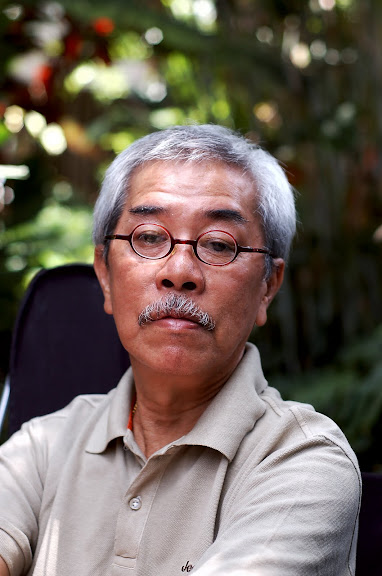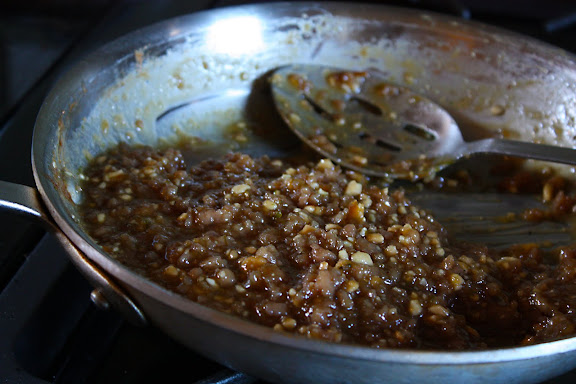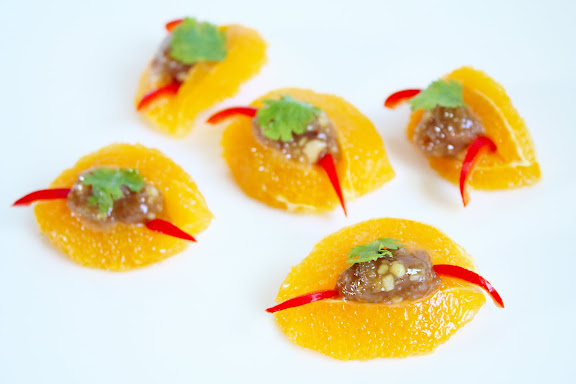
Those who have experienced a mini bliss that involves a Thai-style fried chicken drumstick in one hand and a ball of warm sticky rice in the other don’t need any further convincing that Thai street fried chicken is the stuff of wonders. Now, imagine that same type of fried chicken — in all its glory — done with the southern Thai twist; firm-yet-tender flesh, crispy skin and coating, perfumed with golden fried shallots. Certain types of Bangkok street food when done by members of the Muslim community both from the South and various spots in Bangkok, tend to be exceedingly better than the other versions out there. Fried chicken, in my opinion, is one of them.

Growing up, trips to my paternal grandmother’s house on weekends were filled with both dread and delight in equal measures for me. On the one hand, I knew that some kind of curry would be made, and I would get asked to hop — against my will — on the coconut bunny from Hades. On the other hand, I knew that one of my aunts would stick me in her car1 and we would drive off to a nearby wet market for some Muslim-style fried chicken. Min Buri District on the east side of Bangkok has been home to a sizable Muslim community for such a long time that the residents are used to waking up to the amplified pre-dawn adhān and seeing signs on food carts bearing the crescent moon and star along with both Thai and Arabic writings.
There’s an unspoken understanding: fried chicken vendors with bilingual signs usually have better fried chicken than ones with uni-lingual signs. Don’t ask me why.
I don’t know what activities gave you so much joy when you were a kid. One childhood memory that stands out for me is the quiet moments when I lined up with my aunt for delicious Muslim-style fried chicken trying to decipher the exquisitely beautiful Arabic script on the sign while waiting. It must have been during one of those trips to Bang Kapi market that I committed to my memory the fried chicken procedure while simultaneously deciding I wanted to study languages when I grew up.

What is the difference between Thai-style fried chicken and American-style fried chicken? Typically, American-style batter-fried chicken comprises a crispy/crackly coating covering the juicy meat inside. Thai street fried chicken also has a crispy coating, although it is somewhat thinner and lighter and clings to the entire piece of chicken more tightly. In other words, the point of separation between the coating and the meat in American-style fried chicken is more visible than that in Thai-style fried chicken.
What is the difference between regular Thai-style fried chicken and southern- or Muslim-style Thai fried chicken? Well, not much. It’s just that fried chicken done according to the tradition of the predominantly Muslim South or the Muslim communities throughout the country is, to me, superior in quality. One vendor from whom I buy regularly adds a few lightly-bruised and knotted fresh pandanus leaves to the oil and fries them along with the chicken. The pandanus leaves infuse the oil and, in turn, lightly perfume the chicken. Some vendors insist on adding skin-on quartered onions to the oil for the same effect. This is all optional.
But what tips the scale in favor of Muslim- or Southern-style fried chicken for me personally is the inclusion of crispy fried shallots that add extra savoriness and very pleasant fragrance to the whole thing. It’s optional, of course, but if there is ever an appropriate occasion to gild the lily, this is it.
The more I write, the more I realize how inadequate my words are. You just have to try it.
Success in producing good Thai street fried chicken requires that you pay attention to the following three aspects of it:
The Marinade: Since, like most Thai dishes, Thai-style fried chicken is meant to be eaten with either steamed long grain rice or sticky rice, it’s seasoned in such a way that the flavor is strong enough to compensate for the blandness of the rice. The marinade is, therefore, concentrated with flavor and it’s not used sparingly. The key is to marinate the chicken pieces before they are coated and fried. That way, the flavoring agents don’t merely cling precariously on the coating; they permeate every nook and cranny of the chicken meat all the way to the edible cartilage (which I adore). Larger pieces of chicken quarters are sometimes given a few slashes on the skin all the way to the bones in order to allow the marinade to penetrate more deeply into the meat. The marinade also acts in a similar way to brining; it dissolves protein in the chicken muscle resulting in better moisture retention. This is the very reason why Thai-style fried chicken can be “drier” yet moist. I’m going to pretend the previous sentence makes perfect sense.
The coating: Just before being fried, the marinated chicken pieces are given a quick dip in a rice flour batter which includes no more than rice flour and liquid. Rice flour alone already produces very light and very crispy coating, but some traditionalists make the power of rice flour even more potent and long-lasting by moistening it with limestone water (or 50% limestone water and 50% plain water). If you don’t have limestone water, plain seltzer water(or a mixture of water and baking soda) will work in a pinch.
My personal preference is to dip the marinated chicken in the batter first then give it another coat of plain rice flour. The chicken pieces are then left to dry out on a tray at room temperature for about 15-20 minutes before they go into the hot oil. This helps the rice flour coating to adhere more tightly to the chicken.

The Frying: Well, you know the drill; 350°F oil; cast iron skillet or pot, etc. The only remark that needs to be made is that Thai-style fried chicken stays in the oil longer than usual. As mentioned above, Thai fried chicken is fried up drier than typical American-style fried chicken. This means when you bite into a piece of it, there should be no clear juice dripping down your chin. The meat is firmer and the coating clings to the meat more tightly.
To keep the meat from drying out too much in the fryer, it helps to get good-quality, hormone-free chicken as the individual pieces won’t be so big that by the time the thickest part is cooked just right, the thinnest part is overcooked. I like to use chicken drumsticks and wings, but you can use whatever you like. When I fry my drumsticks, I like to turn them upside-down as shown in the photograph above. That way, the thinnest part doesn’t dry out too much while waiting for the thickest part to cook up.
Once the chicken is done, transfer it to a paper towel-lined tray and let it cool down to slightly warmer than room temperature. Fried chicken is at its best at that stage, in my opinion. Don’t worry that the coating will lose its crispness as it cools; with the rice flour and alkaline of either limestone or soda at work, it won’t. Just make sure that you lay out the chicken pieces in a single layer and with spaces between them so they don’t get steamed.

Thai-style fried chicken is best served with Thai sweet chilli sauce and warm sticky rice (which you can steam with a splatter guard). Lately, I’ve been using a dipping sauce made out of half Thai sweet chilli sauce and half Thai Sriracha; it tastes pretty good.
Leftover fried chicken can be kept refrigerated and re-crisped on a cookie sheet in the oven.
Thai-Style Fried Chicken My Way
(Serves 6)
Printable Version

4 pounds chicken drumsticks (or a combination of your favorite chicken pieces)
Marinade:
6 large cloves of garlic, peeled
2 teaspoons whole coriander seeds
1 tablespoon whole white peppercorns
2 tablespoons finely-chopped cilantro roots or stems
3 tablespoons oyster sauce (or a mixture of 2 tablespoons fish sauce and 2 teaspoons chicken bouillon granules for those avoiding gluten)
2 teaspoons salt
1 teaspoon sugar
Batter:
1 1/2 cups rice flour
1 teaspoon salt
1 teaspoon chicken bouillon granules (optional but highly recommended)
One cup of limestone water (can be substituted with equal amount of plain seltzer water or one cup of plain water mixed with 2 teaspoons baking soda)
Dry coating:
About 2 cups of rice flour
Garnish (optional):
3-4 shallots, very thinly sliced and left to dry out in a single layer on a plate
Aromatics (optional):
2-3 Pandanus leaves, bruised and knotted or
1 large yellow onion, quartered with the skin on
- Pound the first four marinade ingredients in a granite mortaruntil they form a smooth paste. (You can use a small chopper or food processor for this.)
- Add the paste to the chicken along with the remaining marinade ingredients.
- Let the chicken marinate in a covered bowl, in the refrigerator at least 6 hours, up to overnight.
- Whisk together the batter ingredients. The batter will be somewhat thin.
- Dip each piece of chicken (no need to wipe off the marinade) into the batter; make sure it’s entirely coated.
- Immediately coat the battered chicken with rice flour; shake off some of the excess flour. Lay each piece out on a cookie sheet and allow to dry 15-20 minutes at room temperature.
- While waiting for the chicken to dry out, heat up the oil in the fryer along with your aromatics of choice, if desired.
- When the oil temperature reaches 350 F, remove and discard the aromatics and gently drop the chicken pieces into the oil (don’t fry too many at the same time; this causes the oil temperature to drop too low and results in soggy coating).
- Fry the chicken until the inside is thoroughly cooked and the outside is golden brown. If you’re not used to cooking fried chicken Thai-style, cook your chicken to the point when you normally remove it from the fryer, then leave it in the oil about 10 minutes longer, adjusting the heat as needed.
- Once all the chicken pieces have been removed, gently drop the shallot slices into the oil. Once they’re browned and crispy, transfer them with a slotted spoon to a paper towel-lined plate.
- To serve, sprinkle the crispy shallots over the chicken.
- 1 Most of the time, all it took was a tilted head featuring my signature idiotic grin and a series of rapid blinks. Pathetic? Perhaps. Effective? You bet.
















